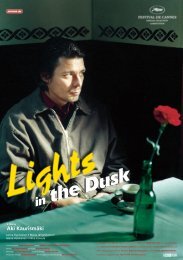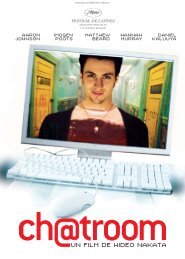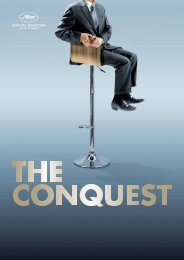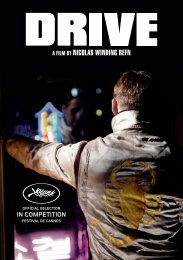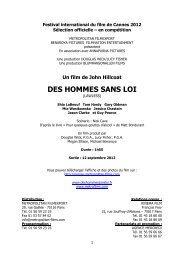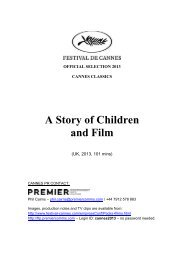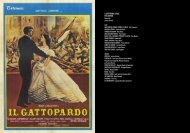English - Cannes International Film Festival
English - Cannes International Film Festival
English - Cannes International Film Festival
You also want an ePaper? Increase the reach of your titles
YUMPU automatically turns print PDFs into web optimized ePapers that Google loves.
In production<br />
with abbas by Kenzo Horikoshi<br />
I watched Abbas Kiarostami’s Close-Up for the first time in 1991, at the Yamagata Documentary <strong>Film</strong><br />
<strong>Festival</strong>, and I was impressed by its meticulous and delicate character. Ever since, for 20 years, I have<br />
distributed his films in my little cinema theater as well as in other arthouse cinemas in Japan.<br />
In 1993 we picked up the very first Iranian film to be distributed commercially in Japan.<br />
Where Is The Friend’s Home? had a documentary nature, but managed to touch a large audience,<br />
struck by its simplicity while still making a strong impression. Akira Kurosawa saw the film and sent us his<br />
thoughts: «I would have loved to have directed such a film.»<br />
During the years to come, Abbas Kiarostami regularly travelled to Japan to promote his films and to<br />
attend the Japanese <strong>Film</strong> <strong>Festival</strong>.<br />
In 2004, he was granted the Praemium Imperiale (an arts prize, annually awarded on behalf of the<br />
Japan Art Association) and, upon his visit to Japan to attend the ceremony, he asked to be introduced to<br />
an elderly lady, an extra, and requested a video camera as well as a car, to use for film tests. Everything<br />
was ready according to his requests. We went to Roppongi, central Tokyo’s entertainment district, for the<br />
film tests. At the time you could often see posters with pictures of call girls in phone booths. Kiarostami<br />
asked the elderly woman to go to a phone booth and bring back a photo of a call girl. That’s when he<br />
started to shoot.<br />
In the following scene, the same woman stood waiting at the corner of a busy street. Following his<br />
directives, the car passed by, observing the woman, while Kiarostami was shooting from inside the car.<br />
Later, this would become the key scene in the first half of Like Someone In Love and the idea for the film<br />
was born from this scene.<br />
In 2010, at the press conference for Certified Copy in selection at the Pusan <strong>Film</strong> <strong>Festival</strong> Kiarostami<br />
suddenly announced, to my great surprise, that his next film would be shot in Japan.<br />
One month later, Kiarostami began casting for his film in Tokyo!<br />
As soon as it became known that the Palme d’Or award-winning director Abbas Kiarostami was casting<br />
for a film to be shot in Tokyo, a large number of acclaimed and famous actors lined up to meet with<br />
him. Among them, some were determined to play the lead roles and subsequently the film financing went<br />
smoothly. With pre-production underway, we planned for the production to start end of March 2011.<br />
But then disaster struck. On March 11, Japan was hit by the most<br />
powerful earthquake it had experienced since 1900 and the tsunami<br />
caused considerable damage to the country’s East Coast. From then on,<br />
all films in production, including ours, were interrupted or held back until<br />
a future date. The financing partners abandoned all their film projects.<br />
Hoping to for a fresh start in May, we realized that our lead actors<br />
were no longer available for rehearsals. Once again, we had to set<br />
up a new casting process. After a few months of casting, the ensemble<br />
was finally confirmed, and apart from the actor Ryo Kase, none of the<br />
lead actors were known to film fans. Kiarostami’s remarkable intuition<br />
allowed us to lock down a cast, in line with the characteristic cast of<br />
his films.<br />
The production finally got under way on October 30 2011<br />
beginning with the first scene of the screenplay written by Kiarostami:<br />
FIRST SCENE - CAFÉ - NIGHT TIME.<br />
But again we suffered a setback. A couple of days later, all the extras<br />
were replaced and the scene was shot again. As expected, Kiarostami’s<br />
direction was completely unique. He would not allow the actors to<br />
read the entire screenplay. Every day, the details of the scene to be<br />
shot the following day were revealed to the actors. They did not know<br />
their characters’ role in the story, nor did they know how the film ends.<br />
To know the end of the story and the fate of the characters could<br />
lead to the actors counter-performing, a sort of «performance with a<br />
downgrading effect».<br />
12 13




